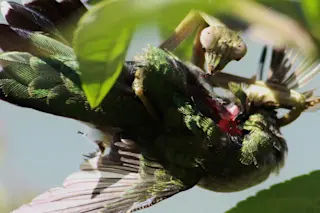Poor hummingbirds. The fragile, fleet-winged birds often don’t make it past their first year of life as they are tasty snacks for cats, large-mouth bass, snakes, lizards…you get the idea. Now, perhaps surprisingly, we can add praying mantises to that macabre list.
A new paper reviewing the avian death-literature finds that praying mantises are enthusiastic predators of the tiny birds, and they go about it in gory fashion, often burrowing in through the eye sockets to tear apart the birds’ brains. Included in a press release are a number of pictures, and the results aren’t pretty:
Going straight for the brain. (Credit: Tom Vaughan)
Tom Vaughan
All in all, researchers from the U.S. and Switzerland found 147 cases of mantis-on-hummingbird predation spanning every continent but Antarctica. Twenty-four species of birds and 12 mantis species were accounted for, an indication that the behavior is widespread. Hummingbirds became mantis easy targets after ...














